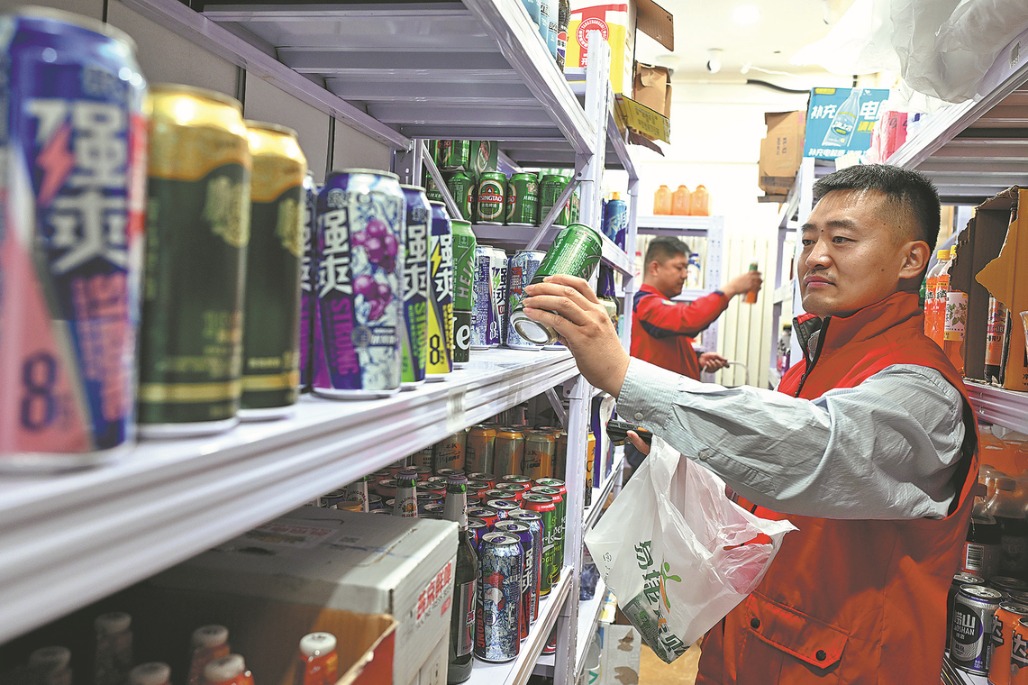Unimpeded internal circulation key to growth


A GDP target of some 5.5 percent has been set for this year, slightly higher than the previous market consensus of between 5.0 percent and 5.5 percent. However, with the ongoing COVID-19 pandemic, geopolitical conflict and resurging commodity prices, the target will be even harder to meet.
The expected external environment in 2022 will be more challenging than in the previous two years, and the driving force from the property sector, which has been an important engine of support for economic growth in the past, will be greatly reduced in the future. Therefore, expanding domestic demand has become the focus of efforts to boost economic growth. Only with unimpeded domestic circulation can domestic demand better play its supporting role.
Slower expansion or fall likely in exports, property
China's economic growth has been mainly driven by exports and real estate over the past two years. In 2021, the country's exports grew 21.2 percent year-on-year while the average growth rate of real estate in 2020 and 2021 was 6 percent, much higher than that of fixed asset investment. But this year, things will be different.
First, the growth of exports is expected to fall in 2022. Given the very high export figures seen in 2021, it is generally considered that exports may not be able to maintain double-digit growth, especially with the ongoing Russia-Ukraine conflict, which has caused prices of crude oil, grains and other commodities to skyrocket once again, adding to downside pressure on the global economy. In addition, China's export share has reached 16 percent of the global total, far ahead of other countries. Against the background of accelerated reduction of working-age populations and the rising average age of workers, there is not much room for improvement.
If the Russia-Ukraine conflict continues or even expands, and the pandemic continues to rage, transportation costs will rise even further this year, thus affecting export growth. In addition, the renminbi exchange rate is likely to continue to appreciate moderately this year, which is also not conducive to exports.
Second, real estate still cannot be used as a major tool to stimulate the economy. This is because it is still proposed in the Government Work Report that China will "adhere to the positioning that houses are for living in, not for speculation", while urging cities to put forward policies to "promote a virtuous circle and healthy development of the real estate industry". In 2021, investment in real estate development accounted for 26.7 percent of that in fixed assets. If the growth rate of real estate investment further declines this year, it may have an impact on investment in fixed assets.
At present, residential real estate inventory is lower than 2014 levels, with no signs of high inventory triggered by excessive investment. It's noteworthy that this is fundamentally different from the crisis in the real estate industry caused by the combination of high amount of land supply and shrinking demand in previous real estate cycles at home and abroad. Moreover, some leading domestic developers are facing liquidity pressure, and it is uncertain whether the decline of newly added construction projects this year can be reversed.
What is behind COVID, conflicts
We are now in the third year of the COVID-19 pandemic, with the virus still mutating, making it barely possible to foretell when it will end.
In addition, though the past decades have witnessed generally rapid development worldwide, thanks to the relatively peaceful international environment, the income disparity has been widening as well around the globe.
In addition, there is also a trade-off in national strength among countries. There are quite a few such examples worldwide. South American countries are very rich in natural resources and developed rapidly in the early stage, but they have all fallen into the middle-income trap since the debt crisis in the 1980s. Russia once entered high-income country territory, and then returned to a middle-income country. Ukraine itself is now one of the poorest countries in Europe in terms of per capita GDP.
On the other side of the coin, the long-term peace has perpetuated GDP champions among nations and widened the global gap between rich and poor, resulting in severe socioeconomic structural distortions. Bridgewater Associates founder Ray Dalio said there are three aspects of the current period similar to 1935-1945: the debt cycle, internal conflict and external order. Both the long-term and short-term debt cycles are nearing their end, and the central banks worldwide have limited room for stimulus. The huge gap between rich and poor and the high degree of political polarization have brought about various internal conflicts. Also, the external world is facing the pressure of a reshaping of the world order.
In short, a global recession is inevitable, and it is also necessary to reshape the world order in some way rather than conflicts and wars, as the world has entered a nuclear era, and the price that human beings will pay for such wars will be way too big.
Dual-circulation matters
The dual-circulation development pattern is a focus that the nation must hold onto in the 14th Five Year Plan period (2021-25).
However, the global environment is not as friendly as it used to be. The COVID-19 pandemic and Sino-US disputes are hindering China's efforts in opening-up and global cooperation. The conflict between Russia and Ukraine has cast a shadow over the global economy. Therefore, we cannot place much expectation on the development of external demand.
While in terms of internal circulation, there are challenges as well that were stated in the Central Economic Work Conference late last year-threefold pressure from shrinking demand, supply shocks and weaker expectations. Problems in China's internal circulation have become relatively prominent. For example, the average level of consumption growth in the past two years is significantly lower than the level before the COVID-19 outbreak, and the growth rate of infrastructure investment is close to zero.
Therefore, with the driving force from exports and realty expected to weaken, the Government Work Report has proposed to "firmly implement the strategy of expanding domestic demand, promote coordinated regional development and new urbanization, smoothen the national economic cycle, open up all links of production, distribution, circulation, and consumption and enhance the driving force of domestic demand for economic growth."
Many measures have been arranged to significantly increase the scale of fiscal expenditure this year. For example, "the deficit rate this year is planned to be around 2.8 percent, which is lower than last year, which is conducive in enhancing fiscal sustainability. But, socioeconomic processes encounter challenges and setbacks every year. Therefore, in addition to setting economic policies at the beginning of the year, we must make discretionary decisions in the middle of the year."
To achieve this year's economic growth target is far from simply increasing fiscal spending. Though in times of economic downturn, fiscal stimulus is far more effective than monetary stimulus, the side effects of fiscal stimulus are also great. Current internal circulation is not smooth, and the key lies in the structural distortion formed under the long-term stable growth model.
China's economic growth model is generally improving, that is, from investment-driven to consumption-driven, from overreliance on external demand to expanding the contribution of domestic demand to the economy, and from high growth to high-quality growth. However, the improvement process is not always as what we anticipated, as in the process of expanding domestic demand, investment still tends to get more focus than consumption.
To this end, measures should be launched to boost consumption, and one we suggest should be to further enlarge the middle-income group and narrow income gaps through ways such as encouraging more high-income earners to shoulder social responsibilities to boost tertiary distribution, which will boost the progress of achieving common prosperity.
There are still many measures to promote consumption, including moves proposed in the report like more green smart home appliances for rural families and home appliance replacement. But ultimately, all these efforts should be reflected in the contribution of consumption to the GDP. In my opinion, the performance evaluation criteria of fiscal expenditure should be diversified, not only in the input-output ratio for investment, but also in the multiplier effect for consumption.
The savings rate of Chinese residents is among the highest globally, especially the high savings rates seen among high-income groups-an important reason for the long-term overheating of real estate and sluggish consumption. Therefore, we should encourage the group to spend more to help boost employment and improve the livelihoods of middle- and low-income earners. However, such a measure can boost the GDP in the short term, but in the long run, it will lead to excess supply and insufficient demand, resulting in problems for internal circulation.
In conclusion, the proportion of total disposable income to the GDP is relatively low, which is not conducive to the expansion of domestic demand and the smooth flow of internal circulation. It is necessary to further increase household incomes while further intensifying the reform of income distribution and optimizing the income structure and economic structure through secondary and tertiary distribution.
The writer is chief economist at Zhongtai Securities.
The views don't necessarily reflect those of China Daily.




































